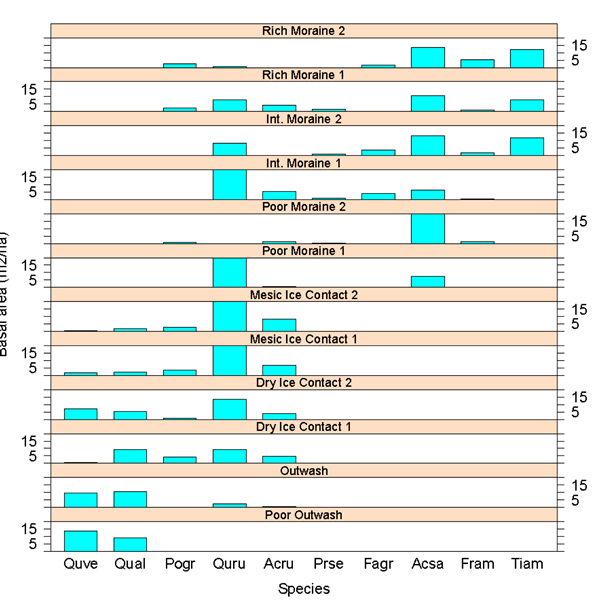Temperate Forest
Abbreviations of species names are the first two letters of the genus and species and include: Quercus velutina, Q. alba, Populus grandidentata, Q. rubra, Acer rubrum, Prunus serotina, Fagus grandifolia, A. saccharum, Fraxinus americana and Tilia americana.
Variation in forest communities across the landscape in northern Michigan is striking. Adjacent sites of different glacial landforms can have no overlap in species composition. The below figure shows species basal area across our 12 primary sites in northwestern lower Michigan. The sites stratify a gradient in soil resource availability (water, calcium and nitrogen), generally increasing across sites from the bottom to the top of the graph.

Several projects have been focused on this fundamental question: why do these tree species occur where they do?
Recent Publications (Complete list of publications)
Qiu, T + 101 co-authors (alphabetical, including RK Kobe), and JS Clark. 202_. Limits to reproduction and seed size-number trade-offs that shape forest dominance and future recovery. Nature Comm, in press.
Journe, V + 91 co-authors (alphabetical, including RK Kobe), and JS Clark. 202_. Globally, tree fecundity exceeds productivity gradients. Ecol. Letters, in press.
Qiu, T + 78 co-authors (alphabetical, including RK Kobe), and JS Clark. 2021. Is there tree senescence? The fecundity evidence. Proceedings of the National Academy of Science 1189(34) e2106130118. https://doi.org/10.1073/PNAS.2106130118
Esch, CM and RK Kobe. 2021. Short-lived legacies of Prunus serotina plant-soil feedbacks. Oecologia 196(2), 529-538. doi: 10.1007/s00442-021-04948-1
Esch, CM, CM Medina- Mora, RK Kobe and ML Sakalidis. 2021. Oomycetes associated with Prunus serotina persist in soil after tree harvest, Fungal Ecology 53: 101094. https://doi.org/10.1016/j.funeco.2021.101094
McCarthy-Neumann, S and RK Kobe. 2019. Site soil-fertility and light availability influence plant-soil feedback. Frontiers in Ecology and Evolution 7:383. doi:10.3389/fevo.2019.00383
Minor, D and RK Kobe. 2017. Masting synchrony in northern hardwood forests: super-producers govern population fruit production. Journal of Ecology 105: 987-998.
Rozendaal, DMA and RK Kobe. 2016. A forest tent caterpillar outbreak increased resource levels and seedling growth in a northern hardwood forest. PLOS ONE 11(11): e0167139. doi:10.1371/journal.pone.0167139.
Maguire, AJ and RK Kobe. 2015. Drought and shade deplete nonstructural carbohydrate reserves in seedlings of five temperate tree species. Ecology and Evolution 5: 5711-5721.
Rozendaal, DMA and RK Kobe. 2014. Competitive balance among tree species altered by forest tent caterpillar defoliation. Forest Ecology and Management 327: 18-25
Kobe, RK, TB Baribault, and EK Holste 2014. Tree performance across gradients of soil resources. In Coomes DA, Burslem DFRP, and Simonson WD (eds.). Forests and Global Change, Ecological Reviews Series, Cambridge University Press, New York.
Baribault, TW and RK Kobe. 2011. Neighbour interactions strengthen with increased soil resources in a northern hardwood forest, Journal of Ecology 99: 1358-1372. doi: 10.1111/j.1365-2745.2011.01862.x
Baribault, TW, RK Kobe, and DE Rothstein. 2010. Soil calcium, nitrogen, and water are correlated with aboveground net primary production in northern hardwood forests. Forest Ecology and Management, 260: 723-733.
Martin, PH, CD Canham, and RK Kobe. 2010. Divergence from the growth-survival trade-off and extreme high growth rates drive patterns of exotic tree invasions in closed-canopy forests. Journal of Ecology 98: 778-789. doi: 10.1111/j.1365-2745.2010.01666.x.
Kobe, RK, M Iyer, and MB Walters. 2010. Optimal partitioning theory revisited: nonstructural carbohydrates dominate root mass responses to nitrogen. Ecology 91: 166-179.
McCarthy-Neumann, S and RK Kobe. 2010. Conspecific and heterospecific tree-soil feedbacks influence survivorship and growth of temperate tree seedlings. Journal of Ecology 98:408-418. doi: 10.1111/j.1365-2745.2009.01620.x
Kunkle, JM, MB Walters, and RK Kobe 2009. Senescence-related changes in nitrogen in fine roots: mass loss affects estimation. Tree Physiology 29: 715-723. http://treephys.oxfordjournals.org/cgi/reprint/29/5/715?ijkey=27bBSwTuD0zknYu&keytype=ref
Kobe, RK and LJ Hogarth. 2007. Evaluation of irradiance metrics with respect to predicting sapling growth, Canadian Journal of Forest Research 37: 1203-1213.
MacFarlane, DW and RK Kobe. 2006. Selecting models for capturing tree size effects on growth- resource relationships. Canadian Journal of Forest Research 36: 1695-1704.
Kobe, RK. 2006. Sapling growth as a function of light and landscape-level variation in soil water and foliar N in northern Michigan. Oecologia 147: 119-133.
Kneeshaw, DD, RK Kobe, KD Coates, and C Messier. 2006. Sapling size influences shade tolerance ranking among southern boreal tree species. Journal of Ecology 94:471-480.
Schreeg, LA, RK Kobe*, and MB Walters. 2005. Tree seedling growth, survival and morphology in response to landscape-level variation in soil resource availability in Northern Michigan. Canadian Journal of Forest Research 35: 263-273.
Rhoads, AG, SP Hamburg, TJ Fahey, TG Siccama, R. Kobe. 2004. Comparing direct and indirect methods of assessing canopy structure in a northern hardwood forest. Canadian Journal of Forest Research 34: 584-591.
Catovsky, S, RK Kobe*, and FA Bazzaz. 2002. Nitrogen induced changes in seedling regeneration and dynamics of mixed conifer-broad-leaved forests. Ecological Applications, 12:1611-1625. (*corresponding author)
Caspersen, JP and RK Kobe. 2001. Interspecific variation in sapling mortality in relation to growth and soil moisture. Oikos 92: 160-168.



 Print
Print Email
Email